Batkhela
Batkhela (Pashto: بټ خيله, Urdu: بٹ خیلہ) is the main tehsil, city and capital of Malakand District, Khyber Pakhtunkhwa, Pakistan. According to the 6th Population & Housing Census - 2017 Census of Pakistan, the population of Batkhela was recorded 68,200.[1] Batkhela is a popular business city in Khyber Pakhtunkhwa province. One water canal that pours into a small dam in Jabban area is main source of electricity production.
Batkhela بټ خيله | |
|---|---|
| Tahsil Batkhela (Malakand District) | |
Batkhela Canal flows through the city | |
| Country | |
| Province | Khyber Pakhtunkhwa |
| District | Malakand |
| Capital/Tehsil | Batkhela |
| Established | March 1895 (British) |
| Government | |
| • Type | Tehsil, City |
| • Governing body | Union Council (3 Seats) |
| • AC/Sub divisional Magistrate/Deputy Commandant | Aun Haider (PAS) |
| • Tehsil Nazim | Fazal Wahid Lalagi (JI) |
| • Upper Batkhela | Saddam Hussain (Independent) |
| Area | |
| • City | 1,001 km2 (386 sq mi) |
| Population (1998 est.) | |
| • Urban | 38 222 |
| Time zone | UTC+5 (PST) |
| Website | nwfp.gov.pk |
Batkhela General Civil Headquarters Hospital is the main hospital of the district Malakand. Batkhela main bazaar is more than 2 kilometres long; there are no intersections (junctions) so no traffic lights. Therefore, it is the longest bazaar in Pakistan also in Asia that has no traffic lights or junctions (intersections) on it.[2][3]
History
Etymology
During the Ashoka and Kanishka Empires Batkhela was ruled by a leader named Butt hence city has given the name Batkhela.
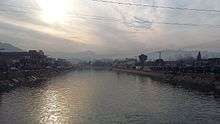
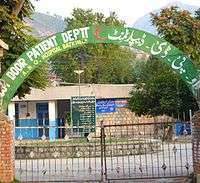
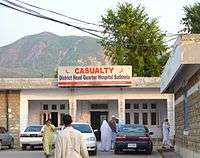
Early history
When Mahmud of Ghazni (997-1030) was attacking India against the Hindus, during this time one of his army leaders Pir Khushal assailed Batkhela, during the course of this assault most of his soldiers were sunk in a big marsh at a place called Ghelai in Batkhela. However, soldiers of his army that survived have preferred to stay in this region. They have not only changed the culture and customs of the local inhabitants but also exerted a strong influence on them to make them convert to Islam.
.jpg)
Early in the 17th century an Afghan tribe Yusufzai (Yusufzai Pathan) invaded Swat region [4] under the leadership of Malik Ahmad Khan, during this period Batkhela was part of Swat valley. At the time Swat was ruled by a ruler named Raees and Swati tribe was permanent inhabitant here. After the invasion most of the Swati tribesmen left this area and escaped to Hazara region. It gave Yusufzai an opportunity to settle here permanently and they declared Thana region (currently part of Batkhela tehsil) is their administrative headquarters.
In the beginning three family classes of Yusufzai tribe were settled in Batkhela (Ibrahim Khel, Husain Khel and Nazrali Khel).
In March 1895 the British Empire invaded this region including Batkhela. Malak Mir Azam Khan of Ibrahim Khel was leading the army of Batkhela. A new political agency for Dir, Swat and Chitral was established.[5] The first officer to be placed in charge of the new Malakand Agency was Major Harold Arthur Deane(1854–1908),[6][7][8][9][10] later on 9 November 1901 Lieutenant Colonel Sir Harold Arthur Deane also became the first Chief Commissioner on the formation of the North-West Frontier Province (now Khyber Pakhtunkhwa).[7][9][10][11][12]
.jpg)
This year when Batkhela was stormed by the 45th Sikhs after a fierce resistance Lieut.-Colonel McRae was the very first British army personnel to enter Batkhela.[13] Before 1895 Batkhela was invaded by different outsiders including Khan of Dir Rahmatullah Khan in 1869 and Wali-i-Dir/Nawab Muhammad Umara Khan as well as Swatis. On capturing Malakand Agency British army have decided to prevent this area permanently from these outside aggressions. The British rulers declare this area as ‘Malakand Protected Area’ (same as present) and so they prepared a police force called Malakand Levies.
Between 1895 and 1912 British made a huge impact on developmental works and infrastructure. They built roads (Batkhela to Chakdara), raised Chakdara and Malakand forts, set up Levies posts all over Malakand Agency, dug Upper Swat Canal and The Benton Tunnel (locally known as Tandail) and construct Headwork’s scheme at Batkhela, Churchill Picket and Jabban Hydropower Station (Jabban Hydropower Plant). The most important of all is the Amandara (part of Batkhela) Irrigation Scheme (bridges) which were designed and built by British firm Ransomes & Rapier, Ltd. Makers of Ipswich in 1912, which is still irrigating a vast land of Sama Tehsil, Mardan and Sawabi Districts and Chakdara area.
The British was ruling this area until the independence of Pakistan on 14 August 1947. All matters of the Tribal system were settled through ‘Jirga System’. The Frontier Crimes Regulation (FCR) system or status was established in 1974 here. Furthermore, regular laws prevailing and the settle laws of district were also extended. Under the FCR Political Agent exercised his powers as a supreme authority while regular courts were established (Civil & Crime courts) after the year 1974.
Governance
Police in district Malakand are known as Levies and their head or commandant is District Coordination Officer (DCO). The current Tehsil Nazim of Batkhela is Fazal Wahid Lalagi Jamat Islami.
Geography
Batkhela is green city and Swat River is flowing in the middle of the city alongside N45. Batkhela is covered by tall hills from all sides and the most of famous peak of them is named ‘Barcharai’.
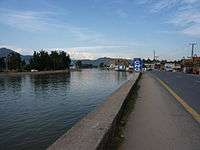
Division
Politically Batkhela is divided into three union councils e.g. Upper, middle and lower Batkhela.
Demography
According to the 6th Population & Housing Census 2017, the population of Batkhela was declared 68,200.[1] Data on religious beliefs across the town in the 2017 census shows that 100% of its population has declared themselves to be Muslim.[14]
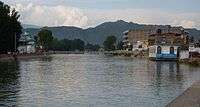
People and culture
More than 95% of local residents are Pashtuns, who are the indigenous inhabitants of the region, and follows the Pashtun's code of conduct "Pashtunwali" in its modern form.
Education
A Primary School was opened in Batkhela in 1915 and a High School was opened in Thana (part of Batkhela tehsil) in 1935 by British rulers. At present, there is one Degree College for boys, One Degree college for girls, two Secondary Schools for boys and one High Secondary School for girls are functioning. In addition, there are several private schools and colleges functioning throughout this region. All schools and colleges are affiliated with Board of Intermediate & Secondary Education (BISE) Malakand.
Media
District Press Club Malakand at Batkhela has been functional since 1988 in a rented building while reporters attached with national, regional and local print and electronic media organizations have been performing their duties with devotion and sincerity. The former minister for information Mian Iftikhar Hussain and minister for finance Engineer Humayun Khan had approved funds for a well-equipped press club building at Batkhela during their term. The remaining funds were approved by the sitting PTI lawmaker Shakil Khan. The construction work on the building has completed now. Soon it will be inaugurated making work of local journalists easier. The first-ever "monthly" the Hidayat Nama was started by late Muhammad Islam Ajmali who has been regarded as founder of journalism in the area. Later on, Mr Amjad Ali Khan started his monthly Tasht from Batkhela that was closed after a few years. The Monthly ‘Nazar’ of Gohar Ali Gohar also closed after two years of circulation. Rab Nawaz Saghir started his ‘Akas’ that closed too. Mr Ihsan ur Rehman Sagar started a monthly Adrash which has been the first-ever declared newspaper from the area. It was made a weekly sometime later and now a daily newspaper. A monthly Nai Dunia is being published by Imran Zaryab from Batkhela and a weekly Manend is also published by Wajid Ali at the moment.
References
- http://www.pbs.gov.pk/content/block-wise-provisional-summary-results-6th-population-housing-census-2017-january-03-2018
- Malakand District: socio-political profile = Pattan Development Organization. Islamabad. 2006. LCCN 2007379799.
- Mohammad Nawaz Khan (1995). Malakand: A journey through history. Gandhara Markaz. p. 12. ASIN B0006FBFNK.
- Horace Arthur Rose; Sir Denzil Ibbetson & Sir Edward Douglas Maclagan (2006). Glossary of the Tribes and Castes of the Punjab and North West Frontier Province. Asian Educational Services, India. p. 125. ISBN 8120605055.
- Donald Sydney Richards (2002). Pakistan The Savage Frontier: A History of the Anglo-Afghan Wars. Pan Books. p. 128. ISBN 0330420526.
- Rizwan Hussain (2005). Pakistan and the Emergence of Islamic Militancy in Afghanistan. Ashgate. p. 36. ISBN 0754644340.
- Bankey Bihari Misra (1991). The Unification and Division of India. OUP India. p. 128. ISBN 019562615X.
- Charles Miller (1977). KHYBER British India's North West Frontier The Story of an Imperial Migraine. McDonald and James. p. 287. ISBN 0025848607.
- Sir Olaf Kirkpatrick Caroe (1976). The Pathans: 550 B.C.-A.D. 1957. OUP Pakistan. p. 386. ISBN 0195772210.
- Victoria Schofield (2003). Afghan Frontier: Feuding and Fighting in Central Asia. Tauris Parke Paperbacks. p. 145. ISBN 1860648959.
- Roger Edward Francis Guilford North (1946). The literature of the North-West Frontier of India: A select bibliography. the University of California. p. 08. OCLC 3131354.
- John F. Riddick (2006). The History of British India: A Chronology. Praeger Publishers Inc. p. 87. ISBN 0313322805.
- Winston Churchill (2007). The Story of The Malakand Field Force. Standard Publications, Inc. p. 60. ISBN 1604245484.
- http://www.pbs.gov.pk/content/population-religion